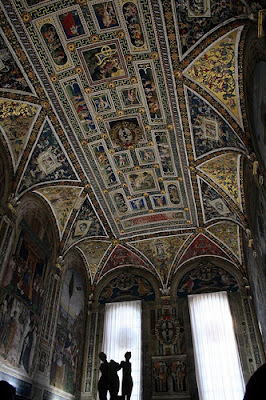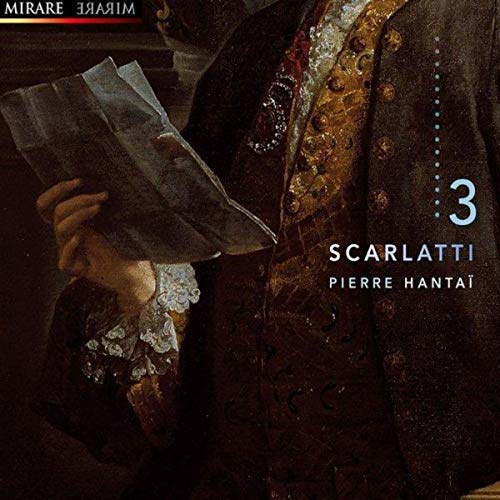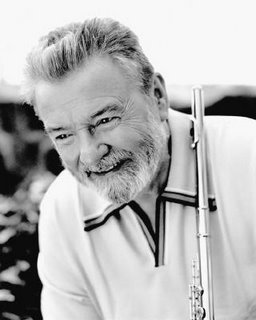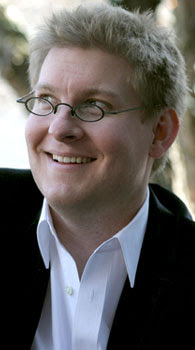Last month | Next monthClassical Month in Washington is a monthly feature. If there are concerts you would like to see included on our schedule, send your suggestions by e-mail (ionarts at gmail dot com). Happy listening!May 1, 2008 (Thu)
7 pmNational Symphony OrchestraComposer Portrait: Aaron Copland
Kennedy Center Concert Hall
May 1, 2008 (Thu)
8 pmBrentano QuartetClarice Smith Center
May 2, 2008 (Fri)
7 pmNational Symphony OrchestraComposer Portrait: Aaron Copland
Kennedy Center Concert Hall
May 2, 2008 (Fri)
7:30 pmHandel,
TamerlanoWashington National Opera
Kennedy Center Opera House
May 2, 2008 (Fri)
7:30 pmPenn State School of Music: President's ConcertKennedy Center Terrace Theater
May 2, 2008 (Fri)
8 pmDavid et JonathasAmerican Opera TheaterDavis Hall, Georgetown University
May 2, 2008 (Fri)
8 pmChamber Orchestra of Philadelphia [FREE]
Library of CongressMay 2, 2008 (Fri)
8 pmHaydn, The CreationUniversity of Maryland School of Music
Clarice Smith Center
May 3, 2008 (Sat)
11 am and 1 pmTeddy Bear ConcertKennedy Center Family Theater
May 3, 2008 (Sat)
7 pmNational Symphony OrchestraComposer Portrait: Aaron Copland
Kennedy Center Concert Hall
May 3, 2008 (Sat)
7:30 pmLiszt-a-Thon: Paul Leavitt, piano
Church of the Reformation (212 E. Capitol Street NE)
May 3, 2008 (Sat)
8 pmDavid et JonathasAmerican Opera TheaterDavis Hall, Georgetown University
May 3, 2008 (Sat)
8 pmBaltimore Symphony OrchestraOrff,
Carmina BuranaMusic Center at Strathmore
May 4, 2008 (Sun)
1 and 3 pmNSO Kinderkonzert: Magical MozartKennedy Center Theater Lab
May 4, 2008 (Sun)
2 pmHandel,
TamerlanoWashington National Opera
Kennedy Center Opera House
May 4, 2008 (Sun)
2 pmLiszt-a-Thon: Paul Leavitt, piano
Church of the Reformation (212 E. Capitol Street NE)
May 4, 2008 (Sun)
3 pmPiano Society of Greater Washington: Recital [FREE]
Calvary Lutheran Church (Silver Spring, Md.)
May 4, 2008 (Sun)
4 pmItzhak Perlman (violin) and Rohan DeSilva (piano)WPAS
Music Center at Strathmore
May 4, 2008 (Sun)
4 pmAmit Peled, cello [FREE]
Phillips CollectionMay 4, 2008 (Sun)
5 pmNaji Hakim, organ [FREE]
Washington National CathedralMay 4, 2008 (Sun)
5 pmDavid et JonathasAmerican Opera TheaterDavis Hall, Georgetown University
May 4, 2008 (Sun)
6:30 pmPoulenc Trio, with Hyu Nah Yu (soprano) [FREE]
National Gallery of ArtMay 4, 2008 (Sun)
8:30 pmKennedy Center Spring GalaTribute to Hollywood film composers (NSO, John Williams)
Kennedy Center Concert Hall
May 7, 2008 (Wed)
7:30 pmFelicity Lott (soprano) and Graham Johnson (piano)Vocal Arts SocietyEmbassy of Austria
May 8, 2008 (Thu)
7 pmNational Symphony OrchestraWith Hilary Hahn (violin) and Hila Plitmann (soprano)
Kennedy Center Concert Hall
May 8, 2008 (Thu)
7:30 pmOpera Scenes [FREE]
Maryland Opera Studio
Clarice Smith Center
May 9, 2008 (Fri)
7:30 pmOpera Scenes [FREE]
Maryland Opera Studio
Clarice Smith Center
May 9, 2008 (Fri)
8 pmNational Symphony OrchestraWith Hilary Hahn (violin) and Hila Plitmann (soprano)
Kennedy Center Concert Hall
May 9, 2008 (Fri)
8 pmSt. Petersburg Quartet, with Michael Tree (viola) [FREE]
Library of CongressMay 10, 2008 (Sat)
11 am and 1 pmTeddy Bear ConcertKennedy Center Family Theater
May 10, 2008 (Sat)
6 pmEmerson String Quartet (Brahms sextets)
Smithsonian Resident Associates
National Museum of Natural History
May 10, 2008 (Sat)
7 pmStrauss,
ElektraWashington National Opera
Kennedy Center Opera House
May 10, 2008 (Sat)
8 pmNational Symphony OrchestraWith Hilary Hahn (violin) and Hila Plitmann (soprano)
Kennedy Center Concert Hall
May 10, 2008 (Sat)
8 pmPuccini,
Madama ButterflyBaltimore Opera
May 10, 2008 (Sat)
8 pmNational PhilharmonicWith Brian Ganz, piano
Music Center at Strathmore
May 11, 2008 (Sun)
2 pmBeth Chandler (flute) and Gabriel Dobner (piano)Kennedy Center Family Theater
May 11, 2008 (Sun)
3 pmWashington Bach ConsortSt. Matthew Passion (with Sara Mingardo)
Music Center at Strathmore
May 11, 2008 (Sun)
4 pmRaphael Trio [FREE]
Phillips CollectionMay 11, 2008 (Sun)
6:30 pmRyan Brown, with members of Opera Lafayette [FREE]
National Gallery of ArtMay 12, 2008 (Mon)
7 pmHandel,
TamerlanoWashington National Opera
Kennedy Center Opera House
May 12, 2008 (Mon)
7:30 pmMiriam Fried (violin) and Jonathan Biss (piano)Kennedy Center Terrace Theater
May 13, 2008 (Tue)
7:30 pmStrauss,
ElektraWashington National Opera
Kennedy Center Opera House
May 13, 2008 (Tue)
7:30 pmeighth blackbird: The Only Moving ThingKennedy Center Terrace Theater
May 14, 2008 (Wed)
7:30 pmPuccini,
Madama ButterflyBaltimore Opera
May 14, 2008 (Wed)
8 pmMoscow Virtuosi Chamber OrchestraWith Olga Kern, piano
Music Center at Strathmore
May 15, 2008 (Thu)
7:30 pmStrauss,
ElektraWashington National Opera
Kennedy Center Opera House
May 16, 2008 (Fri)
8 pmParker Quartet/Borromeo Quartet [FREE]
Library of CongressMay 16, 2008 (Fri)
8 pmPuccini,
Madama ButterflyBaltimore Opera
May 17, 2008 (Sat)
10 am (workshop);
2 pm (concert)
Parker Quartet/Borromeo Quartet [FREE]
Library of CongressMay 17, 2008 (Sat)
2 pmYuliya Gorenman, pianoWPAS
Sidney Harman Hall
May 17, 2008 (Sat)
7:30 pmDmitri Berlinsky (violin) and Elena Baksht (piano)Embassy SeriesEmbassy of Austria
May 17, 2008 (Sat)
8 pmBaltimore Symphony OrchestraWith Thomas Adès, guest conductor
Music Center at Strathmore
May 17, 2008 (Sat)
8 pmPuccini,
Madama ButterflyBaltimore Opera
May 18, 2008 (Sun)
1 and 3 pmNSO Family Concert: All in the Musical FamilyKennedy Center Concert Hall
May 18, 2008 (Sun)
2 pmStrauss,
ElektraWashington National Opera
Kennedy Center Opera House
May 18, 2008 (Sun)
3 pmPuccini,
Madama ButterflyBaltimore Opera
May 18, 2008 (Sun)
4 pmAlon Goldstein, piano [FREE]
Phillips CollectionMay 18, 2008 (Sun)
4 pmJohn Chen, piano
Amadeus Concerts, Emerging Artist Showcase
St. Luke Catholic Church (McLean, Va.)
May 18, 2008 (Sun)
6:30 pmGreat Noise Ensemble [FREE]
National Gallery of ArtMay 18, 2008 (Sun)
7:30 pmKennedy Center Chamber PlayersKennedy Center Terrace Theater
May 18, 2008 (Sun)
7:30 pmJohn Adams,
El NiñoChoral Arts Society of Washington
Kennedy Center Concert Hall
May 20, 2008 (Tue)
7:30 pmHandel,
TamerlanoWashington National Opera
Kennedy Center Opera House
May 21, 2008 (Wed)
7:30 pmSasha Cooke, mezzo-soprano [FREE]
National Museum of Women in the Arts
May 21, 2008 (Wed)
7:30 pmStrauss,
ElektraWashington National Opera
Kennedy Center Opera House
May 22, 2008 (Thu)
7:30 pmHandel,
TamerlanoWashington National Opera
Kennedy Center Opera House
May 24, 2008 (Sat)
7 pmStrauss,
ElektraWashington National Opera
Kennedy Center Opera House
May 25, 2008 (Sun)
2 pmWashington International Competition for Piano [FREE]
Friday Morning Music Club
Kennedy Center Terrace Theater
May 25, 2008 (Sun)
2 pmCavalleria Rusticana (concert version)
Washington National Opera
Kennedy Center Opera House
May 25, 2008 (Sun)
2 pmNational Memorial Day Choral FestivalKennedy Center Concert Hall
May 25, 2008 (Sun)
4 pmAlessio Bax, piano [FREE]
Phillips CollectionMay 27, 2008 (Tue)
7:30 pmStrauss,
ElektraWashington National Opera
Kennedy Center Opera House
May 27, 2008 (Tue)
8 pmRichmond Symphony Orchestra: 50th Anniversary ConcertWith Christopher O'Riley, piano
Kennedy Center Concert Hall
May 29, 2008 (Thu)
7 pmNational Symphony OrchestraAll-Sibelius program (Vladimir Ashkenazy, guest conductor)
Kennedy Center Concert Hall
May 29, 2008 (Thu)
7:30 pmVSA Arts International Young Soloists ConcertKennedy Center Terrace Theater
May 29, 2008 (Thu)
7:30 pmQuatuor Ébène
La Maison FrançaiseMay 29, 2008 (Thu)
8 pmPacifica Quartet [FREE]
Tribute to Elliott Carter
Library of CongressMay 30, 2008 (Fri)
7:30 pmCavalleria Rusticana (concert version)
Washington National Opera
Kennedy Center Opera House
May 30, 2008 (Fri)
7:30 pmTrio Mediaeval and CantusKennedy Center Terrace Theater
May 30, 2008 (Fri)
8 pmNational Symphony OrchestraAll-Sibelius program (Vladimir Ashkenazy, guest conductor)
Kennedy Center Concert Hall
May 31, 2008 (Sat)
7:30 pmI Fagiolini (vocal ensemble)
Kennedy Center Terrace Theater
May 31, 2008 (Sat)
8 pmNational Symphony OrchestraAll-Sibelius program (Vladimir Ashkenazy, guest conductor)
Kennedy Center Concert Hall
May 31, 2008 (Sat)
8 pmInon Barnatan (piano), Liza Ferschtman (violin), Alisa Weilerstein (cello) [FREE]
All-Schubert program
Library of CongressMay 31, 2008 (Sat)
8 pmNational PhilharmonicWith Cho-Liang Lin, violin
Music Center at Strathmore
 After observing the anniversary of a famous Leap Day birthday, we should also note the anniversary of a Leap Day passing, that of St. Oswald. A nephew of the Archbishop of Canterbury, Oswald professed as a Benedictine monk during his studies in France, at the monastery of Fleury, where his uncle had also received the habit. Having gained a reputation as a founder and reformer of monasteries, he was raised to the episcopate, first as Bishop of Worcester and then Archbishop of York. St. Oswald did much to improve the state of monastic education, by bringing leading scholars from Fleury and other places to England.
After observing the anniversary of a famous Leap Day birthday, we should also note the anniversary of a Leap Day passing, that of St. Oswald. A nephew of the Archbishop of Canterbury, Oswald professed as a Benedictine monk during his studies in France, at the monastery of Fleury, where his uncle had also received the habit. Having gained a reputation as a founder and reformer of monasteries, he was raised to the episcopate, first as Bishop of Worcester and then Archbishop of York. St. Oswald did much to improve the state of monastic education, by bringing leading scholars from Fleury and other places to England. He is buried in the priory church of St. Mary in Worcester, which he had helped build.
He is buried in the priory church of St. Mary in Worcester, which he had helped build.












